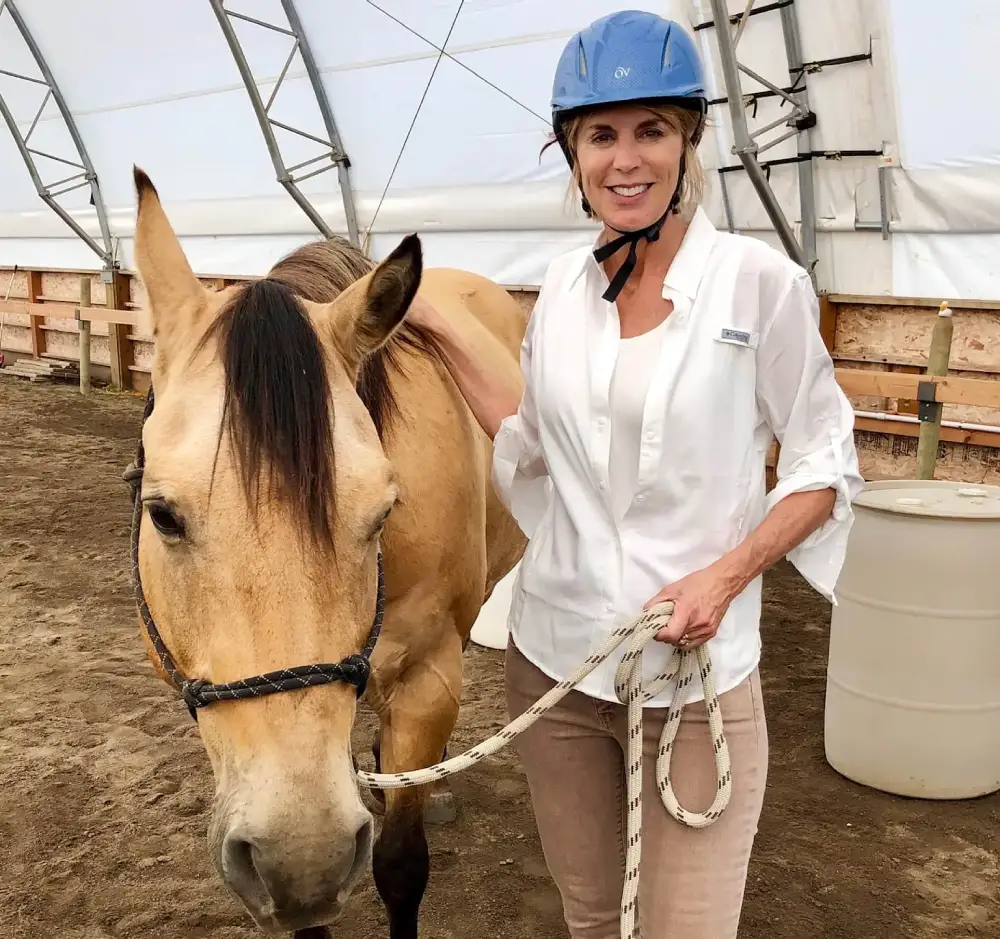
Great leaders know when and how to let go without losing control. I was reminded of this timeless truth and how crucial it is to let go of the reigns more often during a recent experience at a horse ranch in Montana. It’s a lesson I won’t soon forget.
I was in Big Sky country for a business meeting, and our group had decided to spend a morning at Montana Horse Sense, a local “horse camp” just outside of Bozeman. We divided up into pairs at the ranch, and my partner and I chose to work with a beautiful cream-colored horse named Ranger. We then turned our attention to learning some basic skills.
Our first exercise involved haltering our horse and using a lead rope to guide him as we walked from one end of the arena to the other. My partner, who showed cattle in 4-H as a teenager, had no trouble mastering this skill. She kindly helped me manage through this exercise, too, with Ranger following my lead.
Then came the challenge: Convince Ranger to circle a barrel in both directions without the use of a halter or lead rope. Clearly, this is no easy task, especially for a novice like me. A lead rope is an important tool in horse-handling. It attaches to the horse’s halter and allows you to guide your horse where you want him to go as you walk alongside. Pull one direction, and the horse follows. Pull another direction, and he changes course. It’s a straightforward method of control and a very useful one.
But what happens when you have to lead without it?
Sometimes it’s appropriate to take control as a leader. You don’t want chaos and confusion to reign. But many times, you can become heavy-handed, and you risk losing the followership of others. When you focus too much on controlling people and situations, you never develop critical leadership skills you’ll need when control no longer works – or you no longer have positional authority. And you miss the opportunity to become a more thoughtful, influential, trustworthy leader. One who leads because others choose to follow, not because they are coerced to do so.
These realities hit home for me and my partner as we tried everything we could to convince Ranger to circle the barrel. I tried commanding, gesturing and pleading with Ranger, but to no avail. After a few minutes and more than a few false starts, we found a winning combination -- one of us stood in front of Ranger and pointed while the other stood slightly behind Ranger and moved toward him in the direction we wanted him to go. Ranger finally obliged us with a stroll around the barrel.
It was a victory, for sure, thanks largely to my partner’s horse sense and to Ranger’s patience. But the real leadership lesson for me came from what happened next.
After the exercise ended, I spent a few minutes alone with Ranger. Instead of focusing my thoughts and energy on why things didn’t go very well (and what was wrong with me or with him), I just stood quietly by his side, my hand on his shoulder. I began to rub my other hand across his coat and started noticing things about him I hadn’t before – like the two tiny white spots on his back, how his hair changed color depending upon the way the light shone, and the warmth of his body. I quietly praised him, telling him what a good job he had done.
I was fully present, calm, and focused on Ranger, not my own frustration.
Ranger stood very still too, but now in a more relaxed way. His head hung down and his eyes looked a bit sleepy. After a while, he gently turned his head toward me, nuzzling my leg, and smelling my hands. He heaved a big sigh. I could tell we were both in a better place, and I felt a sense of team that comes when a leader and follower willingly choose each other.
A few minutes later, I picked up his halter and placed it on him. I tied it in place, and let the lead rope hang loosely in my hands. Using simple, quiet voice commands, I told Ranger to walk forward with me and then to stop next to me. He did just as I asked. The perfect gentleman. Not a bit of force was needed. While my commanding, gesturing and pleading had clearly not done the trick before, something else was working now.
An excellent book called Lead with Your Heart: Lessons from a Life with Horses by Allan J. Hamilton, provides some meaningful insight on what had changed. “When a horse begins to move himself without a lead rope,” Hamilton writes, “it is because he is enjoying the relationship.”
The lesson is clear. While maintaining a certain level of control is essential when leading a high-performing team, in the end, people willingly follow a leader because they believe she/he cares about them, respects them and has others’ best interests at heart, not just their own.
Relationship and trust, not command and control, carry the day. And as a result, less energy and force are required of the leader, there’s less stress in the execution, and everyone enjoys a greater sense of shared purpose and camaraderie. Frantic, uptight leaders make everyone around them stressed out. Calm, intentional leaders help others relax and focus on accomplishing the goal.
How can you rely less on control and more on trust? Old habits die hard, so it takes time to change your patterns. But here are some simple things you can start doing that will make a big difference when applied consistently:
Do you have team members who say they’ll follow you but resist your lead (overtly or passively)? Almost always this is not a “they” problem, it’s a “you” problem. To earn greater buy-in, you must earn the right to shape their thinking. That’s influence, and that comes more easily when others trust you first.
When you are tempted to rely on control, stop and ask yourself: “What could I do to earn the right to influence?” Suggestions include:
The better you know someone, the better you can lead them. Understanding who your team members are and what makes them tick will allow you to communicate with and motivate them in ways that truly resonate.
Some things you can do to get to know your team members better:
Stop moving 90 miles an hour every minute of every day. Yes, you have a to-do list a mile long, but moving too fast means you’ll miss a lot and risk losing others who no longer want to maintain your pace.
When you are present, things flow more smoothly. You’re more observant. You pick up on cues from others. You know when to speak and when to listen. You’re less likely to jump to conclusions. You have greater clarity about people and situations. You are more available to yourself and others, especially in stressful situations. All of which makes you a more approachable leader and one that others are more willing to trust.
Some tips for being a more present leader:
Leading with a focus on relationships and trust takes commitment and patience, but the rewards take you far beyond the goals you’ll achieve. There’s something powerful about going on a journey with others who want to be there with you and who also are enjoying the experience. Let go of the rope and enjoy the ride.




